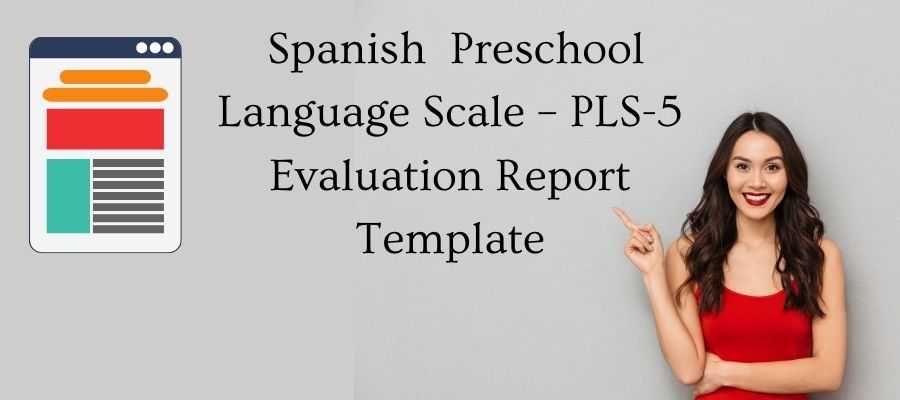
Utilizing the Preschool Language Scale – Fifth Edition - Spanish (PLS-5 Spanish) in practice allows speech language pathologists to accurately assess and monitor the language development of Spanish-speaking preschoolers, capturing both receptive and expressive language skills. This tool ensures culturally and linguistically appropriate evaluations, facilitating targeted, effective intervention strategies.
Get the PLS-5 - Spanish report template emailed to you!
Easily modify and paste this template into your report. Send us a request at admin@evalubox.com. including the template name in the email or subject line.
PLS-5 - Spanish Report Template Text
We Break Out Reports into Structured Sections: Overview, Data Analysis, and Interpretation for the Preschool Language Scale – Fifth Edition - Spanish
PLS-5 - Spanish Evaluation Report Template
Formal testing was conducted in both English and Spanish using a bilingual assessment. The PLS-5: Spanish is a standardized measure that evaluates receptive, expressive, and total language scores of children from birth to 7 years, 11 months. The PLS-5: Spanish is composed of two standardized scales: Auditory Comprehension and Expressive Communication. The Auditory Comprehension (AC) scale is used to evaluate the scope of a child’s comprehension of language. The Expressive Communication (EC) scale is used to determine how well a child communicates with others. These scales survey communication skills in the areas of social communication, semantics, morphology, syntax, and articulation. The PLS-5: Spanish allows for credit to be given for test items observed through spontaneous productions in and outside of the assessment environment. Because it is a bilingual test, standardized procedures also allow credit to be given for items missed in Spanish which are then readministered in English and subsequently passed, resulting in a cumulative score.
PLS-5: Spanish standard scores for receptive, expressive, and total language have a mean of 100 and a standard deviation of 1.5. The percentile rank indicates the percentage of children of a certain age who earned a particular score or lower.
{$student_firstname}’s language skills were evaluated using both formal and informal measures. Results are below followed by an explanation.
Preschool Language Scale – Fifth Edition - Spanish (PLS-5 Spanish)
(Mean=100)
The PLS-5 Spanish Edition was normed on children from Spanish-speaking homes living in the U.S.
*90% Confidence Interval
Norming Information for Your Preschool Language Scale – Fifth Edition - Spanish Report Template
According to Pearson, the Preschool Language Scale – Fifth Edition - Spanish (PLS-5 Spanish) is normed on a representative sample of Spanish-speaking children aged birth to 7 years 11 months. The sample includes diverse linguistic, ethnic, and socioeconomic backgrounds, ensuring the tool's validity and reliability in assessing early language skills in Spanish-speaking populations (Pearson, 2012). [Reference: https://www.pearsonassessments.com/store/usassessments/en/Store/Professional-Assessments/Academic-Learning/Oral-Language/Preschool-Language-Scale-%7C-Fifth-Edition-Spanish/p/100000421.html]
Preschool Language Scale – Fifth Edition - Spanish Evaluation Report Template Tables
Tables in the report template for the Preschool Language Scale – Fifth Edition - Spanish are essential for summarizing data across various language domains, such as auditory comprehension and expressive communication. These tables provide clarity and detailed insights into a child’s language abilities in Spanish, helping to identify specific areas of strength and those needing improvement. This facilitates targeted, culturally, and linguistically appropriate intervention planning and progress monitoring.
Formal testing was conducted in both English and Spanish using a bilingual assessment. The PLS-5: Spanish is a standardized measure that evaluates receptive, expressive, and total language scores of children from birth to 7 years, 11 months. The PLS-5: Spanish is composed of two standardized scales: Auditory Comprehension and Expressive Communication. The Auditory Comprehension (AC) scale is used to evaluate the scope of a child’s comprehension of language. The Expressive Communication (EC) scale is used to determine how well a child communicates with others. These scales survey communication skills in the areas of social communication, semantics, morphology, syntax, and articulation. The PLS-5: Spanish allows for credit to be given for test items observed through spontaneous productions in and outside of the assessment environment. Because it is a bilingual test, standardized procedures also allow credit to be given for items missed in Spanish which are then readministered in English and subsequently passed, resulting in a cumulative score.
PLS-5: Spanish standard scores for receptive, expressive, and total language have a mean of 100 and a standard deviation of 1.5. The percentile rank indicates the percentage of children of a certain age who earned a particular score or lower.
{$student_firstname}’s language skills were evaluated using both formal and informal measures. Results are below followed by an explanation.
Preschool Language Scale – Fifth Edition - Spanish (PLS-5 Spanish)
(Mean=100)
The PLS-5 Spanish Edition was normed on children from Spanish-speaking homes living in the U.S.
*90% Confidence Interval
Get the PLS-5 - Spanish report template emailed to you!
Easily modify and paste this template into your report. Send us a request at admin@evalubox.com. including the template name in the email or subject line.
